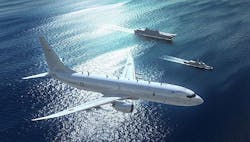Officials of the U.S. Naval Air Systems Command at Patuxent River Naval Air Station, Md., announced a $68.4 million order Thursday to the Boeing Defense, Space & Security segment in Seattle for long-lead items for four future RAF P-8A aircraft.
The P-8 is a militarized version of the Boeing 737 single-aisle jetliner hardened for long-range maritime patrol and anti-submarine warfare (ASW) missions. For the RAF the P-8 is scheduled to replace the now-retired Hawker Siddeley/BAE Systems Nimrod MR2 -- a maritime patrol version of the de Havilland Comet jet airliner. The Nimrod was in service from 1967 to 2011.
The United Kingdom Ministry of Defence ordered nine P-8A aircraft last month to replace the Nimrod MR2. The RAF will base its future P-8As at RAF Lossiemouth in Scotland, which will bring an additional 400 military personnel RAF Lossiemouth air base. Operators of the P-8A are the U.S., Australia, India, and the United Kingdom.
Thursday's contract modification provides for long-lead parts and efforts related to the manufacture of two full-rate production 4 Lot 8 P-8A multi-mission maritime aircraft for the RAF under the Foreign Military Sales (FMS) program. Long-lead items involve system components that require the longest time to build, which could delay overall system production if money isn't allocated for production early in the process.
The P-8A is designed to operate at high altitudes for wide-area reconnaissance, as well as extremely low altitudes over the ocean during close-in searches for potentially hostile submarines. The P-8A is designed to withstand the rigors of low-altitude turbulence and exposure to salt spray.
The aircraft also can remain at high altitudes while hunting for submarines with help from the Northrop Grumman RQ-4N Triton Broad Area Maritime Surveillance (BAMS) unmanned aerial vehicle (UAV) -- a maritime-patrol version of the Global Hawk long-range surveillance UAV.
The U.S. Navy plans call for using BAMS to detect potentially hostile submarines and surface ships, and upon detection, to call in the P-8A to take a closer look or to attack hostile vessels with torpedoes and missiles. The P-8A also can release torpedoes from high altitudes, and has a UAV-based magnetic anomaly detector (MAD) in development.
Boeing is building the Poseidon aircraft at its factory in Renton, Wash. The 737 fuselage and tail sections will come from Spirit AeroSystems in Wichita, Kan., then transferred to Renton where technicians assemble all structural features in sequence.
The P-8A’s flight management system and the stores management system are from GE Aviation Systems in Grand Rapids, Mich. The plane's cabin has as many as seven operator consoles.
The Poseidon’s MX-20HD digital electro-optical and infrared (EO/IR) multi-spectral sensor turrets come from L-3 Communications Wescam in Burlington, Ontario. The MX-20HD is gyro-stabilized and can have as many as seven sensors, including infrared, CCDTV, image intensifier, laser rangefinder, and laser illuminator.
The aircraft has the upgraded APS-137D(V)5 maritime surveillance radar and signals intelligence (SIGINT) system from the Raytheon Co. Space and Airborne Systems (SAS) segment in McKinney, Texas.
The APS-137D(V)5 radar, which is installed on the P-8’s enlarged nose fairing, provides synthetic aperture radar (SAR) for imaging stationary ships and small vessels, coastal and overland surveillance, and high-resolution imaging synthetic aperture radar (ISAR) for imaging surfaced submarines and fast surface vessels operating in coastal waters.
The P-8A will have the CAE Inc. advanced integrated magnetic anomaly detection (MAD) system. The Navy plans to arm the P-8A with the MK 54 torpedo.
On this contract modification Boeing will do the work in Seattle; Baltimore; Greenlawn and North Amityville, N.Y.; and Cambridge, England, and should be finished by July 2017.
For more information contact Boeing online at www.boeing.com, the United Kingdom Royal Air Force at www.raf.mod.uk, or Naval Air Systems Command at www.navair.navy.mil.
Learn more: search the Aerospace & Defense Buyer's Guide for companies, new products, press releases, and videos



